A Cross-Scale Framework for Modelling Chloride Ions Diffusion in C-S-H: Combined Effects of Slip, Electric Double Layer and Ion Correlation
Abstract
1. Introduction
2. Experimental and Computational Method
2.1. Establishment of Migration Model at Pore Scale
2.2. Reconstruction of C-S-H Model
2.3. Rationality Verification of QSGS Model
2.3.1. Pore Distribution
2.3.2. Surface Fractal Dimension
2.3.3. The Migration Model of Chloride Ions in C-S-H
3. Results and Discussion
3.1. Migration Model Analysis on Pore Scale
3.2. The Effect of C-S-H Anisotropy on Diffusion Flux
3.3. The Effect of Slippage on Diffusion Flux
3.4. The Effect of Time-Varying EDL on Diffusion Flux
4. Conclusions
- C-S-H is inhomogeneous and the diffusion flux of chloride ion is affected by the relative proportion of HD C-S-H and LD C-S-H. With the increase of the ratio of HD C-S-H, the diffusion flux of chloride ion decreases gradually, because the transmission of chloride ion is hindered due to the compact structure of HD C-S-H.
- Slip effect is the dominant factor affecting the diffusion ability of C-S-H. With increasing , the contribution of the slip effect to the diffusion flux is up to 50% under strong ion correlation and this value is even higher, up to 60%, under weak ion correlation.
- Compared with the contribution rate of slip effect, the contribution rate of EDL time-varying is slightly insufficient and has no significant change under different ion correlations, the contribution rate only up to about 15%.
- The slip effect is sensitive to both ion correlation and C-S-H inhomogeneity. The contribution rate of ion correlation to the slip effect is about 10%, and the value changes from 0.2 to 0.8, resulting in a contribution rate change of about 15%. EDL time-varying is almost insensitive to ion correlation changes; the value changes from 0.2 to 0.8, resulting in a contribution rate change of about 5%. It is not difficult to see that the slip effect under the weak ion correlation phase has the strongest reaction to the change of C-S-H homogeneity, and the time-varying reaction of EDL under the strong ion correlation is the weakest.
- The significance of this study is not only to quantify the influence of interface effects on the overall diffusivity of C-S-H, thus improving the accuracy of predicting the life of concrete, but also to provide new insights into improving the durability of concrete by changing the solid–liquid interface on the micro-nanoscale.
Author Contributions
Funding
Institutional Review Board Statement
Informed Consent Statement
Data Availability Statement
Conflicts of Interest
References
- Liu, Z.; Chen, W.; Zhang, Y.; Lv, H. A three-dimensional multi-scale method to simulate the ion transport behavior of cement-based materials. Constr. Build. Mater. 2016, 120, 494–503. [Google Scholar] [CrossRef]
- Liu, G.; Zhang, Y.; Ni, Z.; Huang, R. Corrosion behavior of steel submitted to chloride and sulphate ions in simulated concrete pore solution. Constr. Build. Mater. 2016, 115, 1–5. [Google Scholar] [CrossRef]
- Garboczi, E.J.; Bentz, D.P. Computer simulation of the diffusivity of cement-based materials. J. Mater. Sci. 1992, 27, 2083–2092. [Google Scholar] [CrossRef]
- Wang, L.; Guo, F.; Lin, Y.; Yang, H.; Tang, S.W. Comparison between the effects of phosphorous slag and fly ash on the C-S-H structure, long-term hydration heat and volume deformation of cement-based materials. Constr. Build. Mater. 2020, 250, 118807. [Google Scholar] [CrossRef]
- Wang, L.; Jin, M.; Zhou, S.; Tang, S.; Lu, X. Investigation of microstructure of C-S-H and micro-mechanics of cement pastes under NH4NO3 dissolution by 29Si MAS NMR and microhardness. Measurement 2021, 185, 110019. [Google Scholar] [CrossRef]
- Bapat, J.D. A New Compilation on Mineral Admixtures; CRC Press/Taylor & Francis Croup: Boca Raton, FL, USA, 2012; Volume 27. [Google Scholar]
- Das, B.B.; Kondraivendhan, B. Implication of pore size distribution parameters on compressive strength, permeability and hydraulic diffusivity of concrete. Constr. Build. Mater. 2012, 28, 382–386. [Google Scholar] [CrossRef]
- Atzeni, C.; Pia, G.; Sanna, U. A geometrical fractal model for the porosity and permeability of hydraulic cement pastes. Constr. Build. Mater. 2010, 24, 1843–1847. [Google Scholar] [CrossRef]
- Lange, D.A.; Jennings, H.M.; Shah, S.P. Image analysis techniques for characterization of pore structure of cement-based materials. Cem. Concr. Res. 1994, 24, 841–853. [Google Scholar] [CrossRef]
- Powers, T.C.; Copeland, L.E.; Hayes, J.C.; Mann, H.M. Permeability of Portland Cement Paste. ACI J. 1954, 51, 285–298. [Google Scholar]
- Constantinides, G.; Ulm, F.J. The effect of two types of C-S-H on the elasticity of cement-based materials: Results from nanoindentation and micromechanical modeling. Cem. Concr. Res. 2004, 34, 67–80. [Google Scholar] [CrossRef]
- Zhang, Y.; Liu, C.; Liu, Z.; Liu, G.; Yang, L. Modelling of diffusion behavior of ions in low-density and high-density calcium silicate hydrate. Constr. Build. Mater. 2017, 155, 965–980. [Google Scholar] [CrossRef]
- Sivebaek, I.M.; Samoilov, V.N.; Persson, B.N.J. Squeezing molecularly thin alkane lubrication films: Layering. Tribol. Lett. 2004, 16, 195–200. [Google Scholar] [CrossRef]
- Wang, F.; Zhao, Y. The unique properties of the solid-like confined liquid films: A large scale molecular dynamics simulation approach. Acta Mech. Solida Sin. 2011, 24, 101–116. [Google Scholar] [CrossRef][Green Version]
- Lauga, E.; Brenner, M.; Stone, H. Microfluidics: The No-Slip Boundary Condition. In Springer Handbook of Experimental Fluid Mechanics; Tropea, C., Yarin, A.L., Foss, J.F., Eds.; Springer: Berlin/Heidelberg, Germany, 2007; pp. 1219–1240. [Google Scholar]
- Li, C.; Liu, Z.; Liu, X.; Feng, Z.; Mo, X. Combined effect of surface charge and boundary slip on pressure-driven flow and convective heat transfer in nanochannels with overlapping electric double layer. Int. J. Heat Mass Transf. 2021, 176, 121353. [Google Scholar] [CrossRef]
- Vinogradova, O.I. Drainage of a Thin Liquid Film Confined between Hydrophobic Surfaces. Langmuir 1995, 11, 2213–2220. [Google Scholar] [CrossRef]
- Vinogradova, O.I. Adhesion of particles of different degrees of hydrophobicity to a bubble in a collision. Colloid J. Russ. Acad. Sci. C/C Kolloidn. Zhurnal 1993, 55, 517. [Google Scholar]
- Vinogradova, O.I. Slippage of water over hydrophobic surfaces. Int. J. Miner. Process. 1999, 56, 31–60. [Google Scholar] [CrossRef]
- Martini, A.; Hsu, H.-Y.; Patankar, N.A.; Lichter, S. Slip at High Shear Rates. Phys. Rev. Lett. 2008, 100, 195–198. [Google Scholar] [CrossRef]
- Song, F.Q.; Zhang, X.; Huang, X.H.; Long, Y.Q. The flow characteristics of shale gas through shale rock matrix in nano-scale and water imbibition on shale sheets. Sci. Sin. Technol. 2016, 46, 120–126. [Google Scholar]
- Han, X.; An, X.; Maekawa, K. Hygro-Gradient Model for Permeability of Unsaturated Cementitious Composites. J. Adv. Concr. Technol. 2017, 15, 407–425. [Google Scholar] [CrossRef][Green Version]
- Chatterji, S.; Kawamura, M. Electrical double layer, ion transport and reactions in hardened cement paste. Cem. Concr. Res. 1992, 22, 774–782. [Google Scholar] [CrossRef]
- Chatterji, S. Transportation of ions through cement based materials. Part 3 experimental evidence for the basic equations and some important deductions. Cem. Concr. Res. 1994, 24, 1229–1236. [Google Scholar] [CrossRef]
- Grahame, D.C. The electrical double layer and the theory of electrocapillarity. Chem. Rev. 1947, 41, 441–501. [Google Scholar] [CrossRef] [PubMed]
- Friedmann, H.; Amiri, O.; Ait-Mokhtar, A. Physical modeling of the electrical double layer effects on multispecies ions transport in cement-based materials. Cem. Concr. Res. 2008, 38, 1394–1400. [Google Scholar] [CrossRef]
- Nguyen, P.T.; Amiri, O. Study of electrical double layer effect on chloride transport in unsaturated concrete. Constr. Build. Mater. 2014, 50, 492–498. [Google Scholar] [CrossRef]
- Hu, X.; Shi, C.; Yuan, Q.; Zhang, J.; De Schutter, G. Influences of chloride immersion on zeta potential and chloride concentration index of cement-based materials. Cem. Concr. Res. 2018, 106, 49–56. [Google Scholar] [CrossRef]
- Butler, J.C.; Angelini, T.; Tang, J.X.; Wong, G.C.L. Ion multivalence and like-charge polyelectrolyte attraction. Phys. Rev. Lett. 2003, 91, 028301. [Google Scholar] [CrossRef]
- Quesada-Perez, M.; Martin-Molina, A.; Hidalgo-Alvarez, R. Simulation of electric double layers undergoing charge inversion: Mixtures of mono- and multivalent ions. Langmuir 2005, 21, 9231–9237. [Google Scholar] [CrossRef]
- Grosberg, A.Y.; Nguyen, T.T.; Shklovskii, B.I. Colloquium: The physics of charge inversion in chemical and biological systems. Rev. Mod. Phys. 2002, 74, 329–345. [Google Scholar] [CrossRef]
- Lyklema, J. Overcharging, charge reversal: Chemistry or physics? Colloids Surf. A Physicochem. Eng. Asp. 2006, 291, 3–12. [Google Scholar] [CrossRef]
- Travesset, A.; Vangaveti, S. Electrostatic correlations at the Stern layer: Physics or chemistry? J. Chem. Phys. 2009, 131, 185102. [Google Scholar] [CrossRef] [PubMed]
- Hou, D.; Zhang, W.; Sun, M.; Wang, P.; Wang, M.; Zhang, J.; Li, Z. Modified Lucas-Washburn function of capillary transport in the calcium silicate hydrate gel pore: A coarse-grained molecular dynamics study. Cem. Concr. Res. 2020, 136, 106166. [Google Scholar] [CrossRef]
- Zhou, Y.; Hou, D.; Jiang, J.; Wang, P. Chloride ions transport and adsorption in the nano-pores of silicate calcium hydrate: Experimental and molecular dynamics studies. Constr. Build. Mater. 2016, 126, 991–1001. [Google Scholar] [CrossRef]
- Wang, M.; Zhang, K.; Ji, X.; Wang, P.; Ma, H.; Zhang, J.; Hou, D. Molecular insight into the fluidity of cement pastes: Nano-boundary lubrication of cementitious materials. Constr. Build. Mater. 2022, 316, 125800. [Google Scholar] [CrossRef]
- Yu, J.; Zheng, Q.; Hou, D.; Zhang, J.; Li, S.; Jin, Z.; Wang, P.; Yin, B.; Wang, X. Insights on the capillary transport mechanism in the sustainable cement hydrate impregnated with graphene oxide and epoxy composite. Compos. Part B Eng. 2019, 173, 106907. [Google Scholar] [CrossRef]
- Yang, J.; Jia, Y.; Hou, D.; Wang, P.; Jin, Z.; Shang, H.; Li, S.; Zhao, T. Na and Cl immobilization by size controlled calcium silicate hydrate nanometer pores. Constr. Build. Mater. 2019, 202, 622–635. [Google Scholar] [CrossRef]
- Peng, W.; Qi, Y.; Zhang, W.; Jing, Y.; Cheng, H. Migration of water and ions in nanopores under different ion-ion correlation strength condition. Colloids Surf. A Physicochem. Eng. Asp. 2022, 648, 129273. [Google Scholar] [CrossRef]
- Wang, M.; Pan, N. Numerical analyses of effective dielectric constant of multiphase microporous media. J. Appl. Phys. 2007, 101, 114102. [Google Scholar] [CrossRef]
- Jin, S.; Zhang, J.; Huang, B. Fractal analysis of effect of air void on freeze–thaw resistance of concrete. Constr. Build. Mater. 2013, 47, 126–130. [Google Scholar] [CrossRef]
- Yang, B.; Liu, Y. Application of Fractals to Evaluate Fractures of Rock Due to Mining. Fractal Fract. 2022, 6, 96. [Google Scholar] [CrossRef]
- Wang, L.; Huang, Y.; Zhao, F.; Huo, T.; Chen, E.; Tang, S. Comparison between the Influence of Finely Ground Phosphorous Slag and Fly Ash on Frost Resistance, Pore Structures and Fractal Features of Hydraulic Concrete. Fractal Fract. 2022, 6, 598. [Google Scholar] [CrossRef]
- Liu, X.; Nie, B. Fractal characteristics of coal samples utilizing image analysis and gas adsorption. Fuel 2016, 182, 314–322. [Google Scholar] [CrossRef]
- Garboczi, E.J.; Bentz, D.P. Modelling of the microstructure and transport properties of concrete. Constr. Build. Mater. 1996, 10, 293–300. [Google Scholar] [CrossRef]
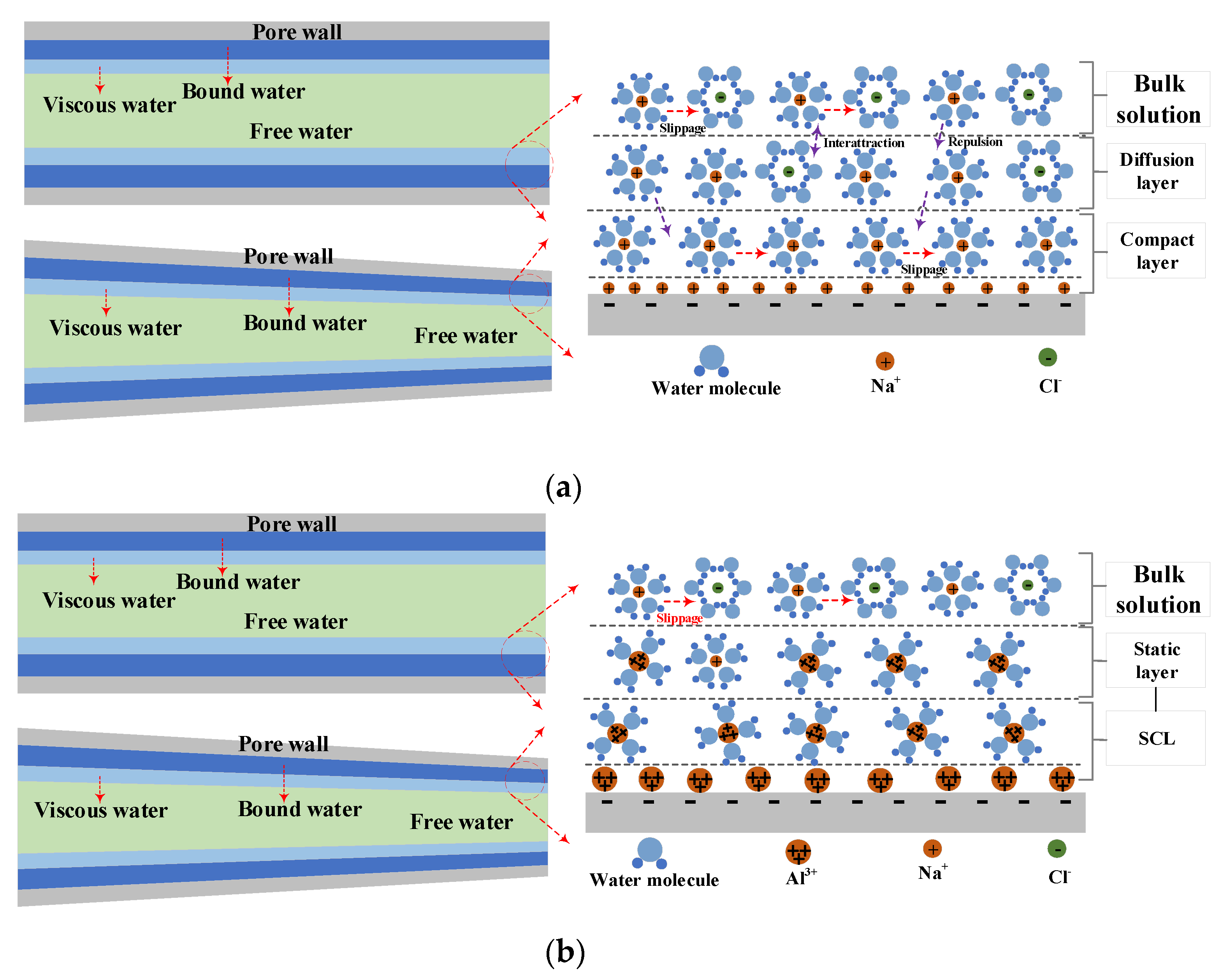

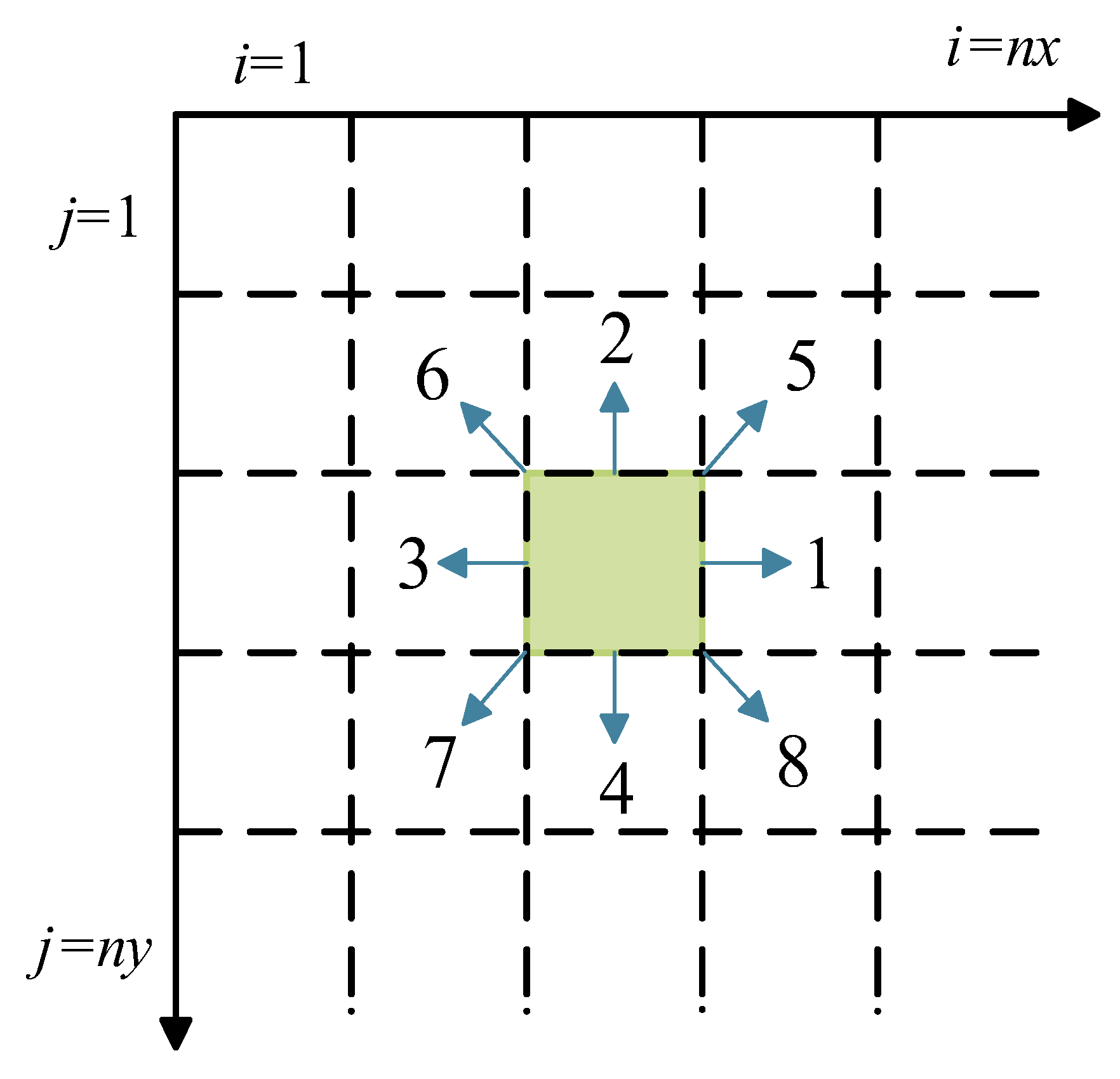

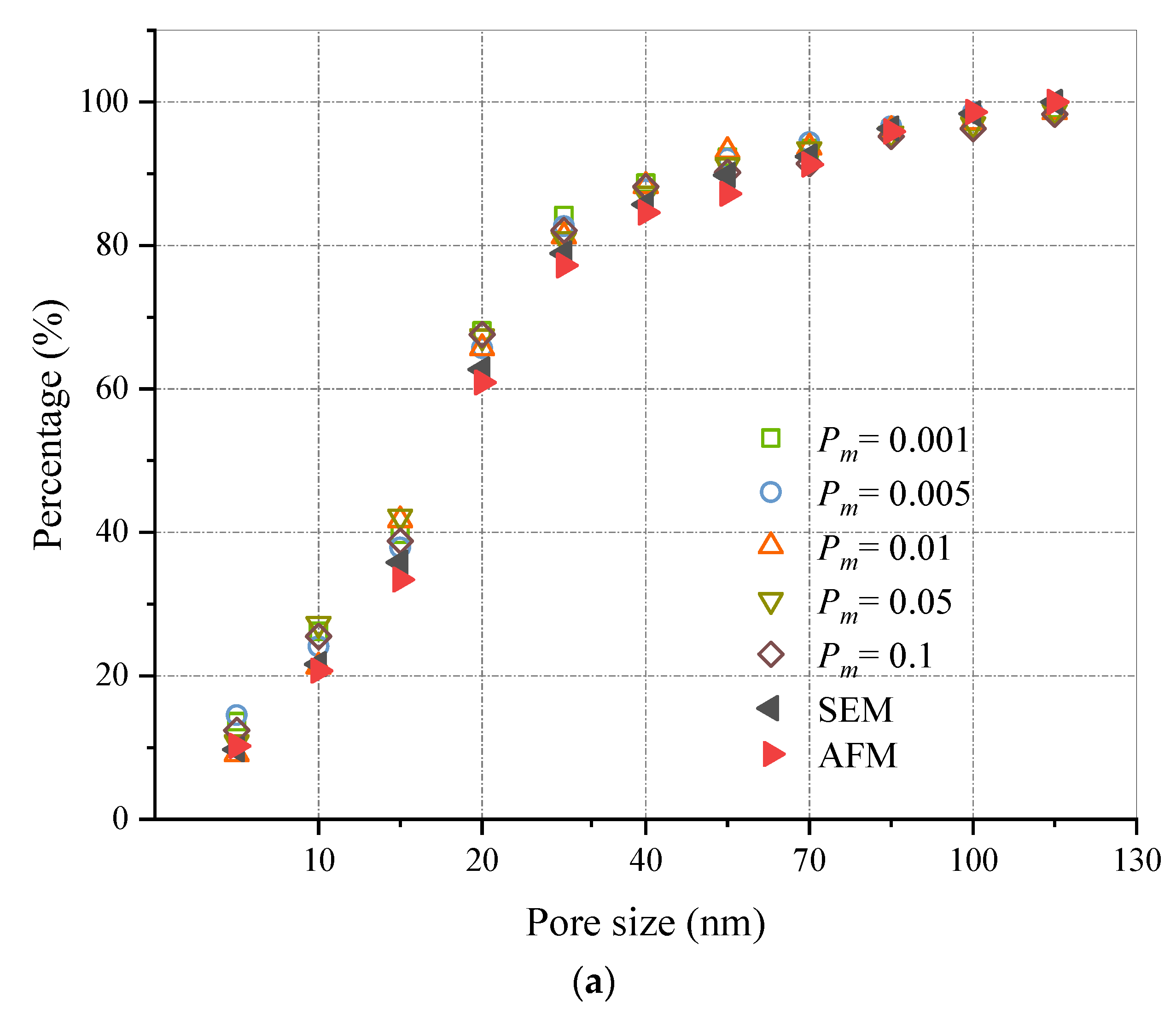


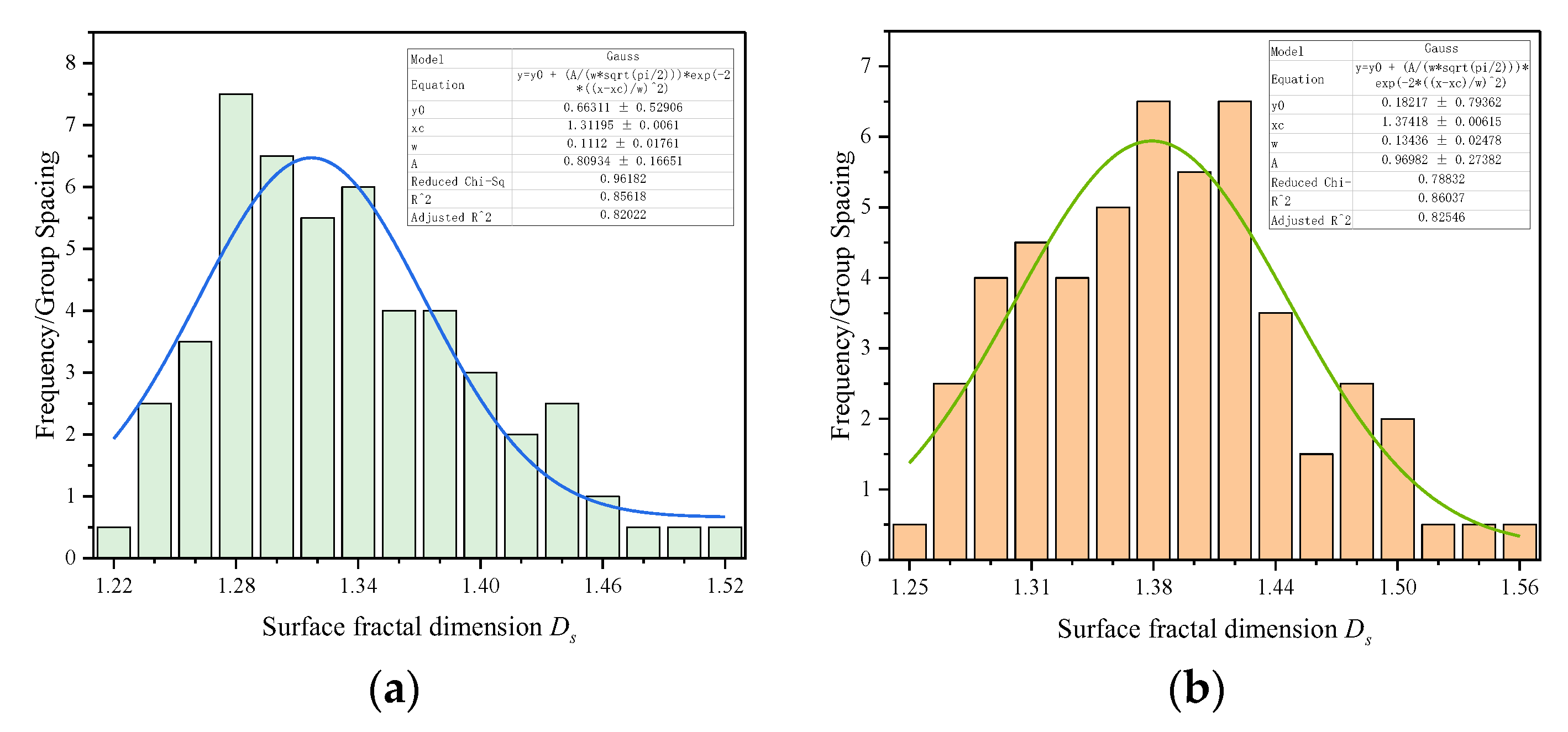

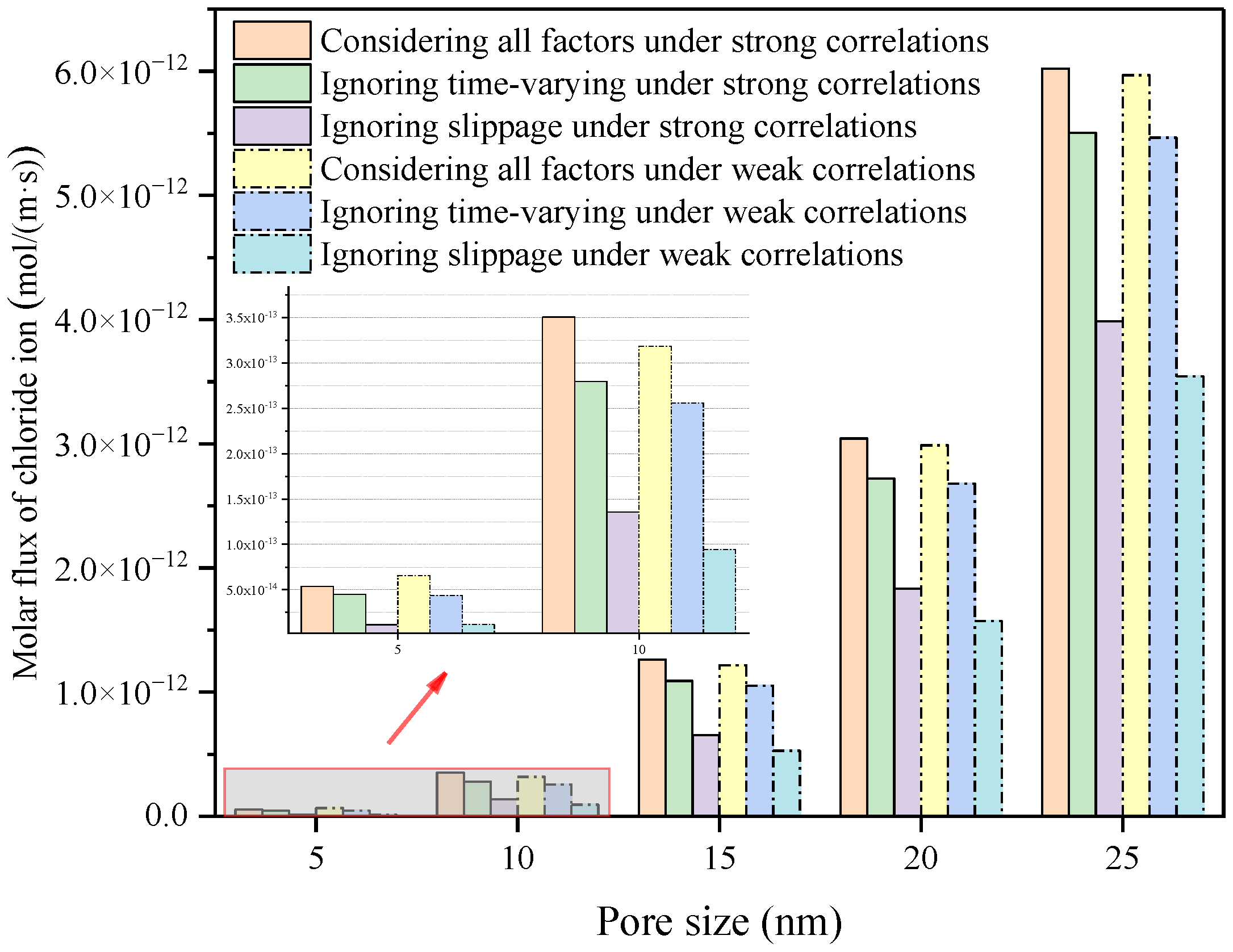
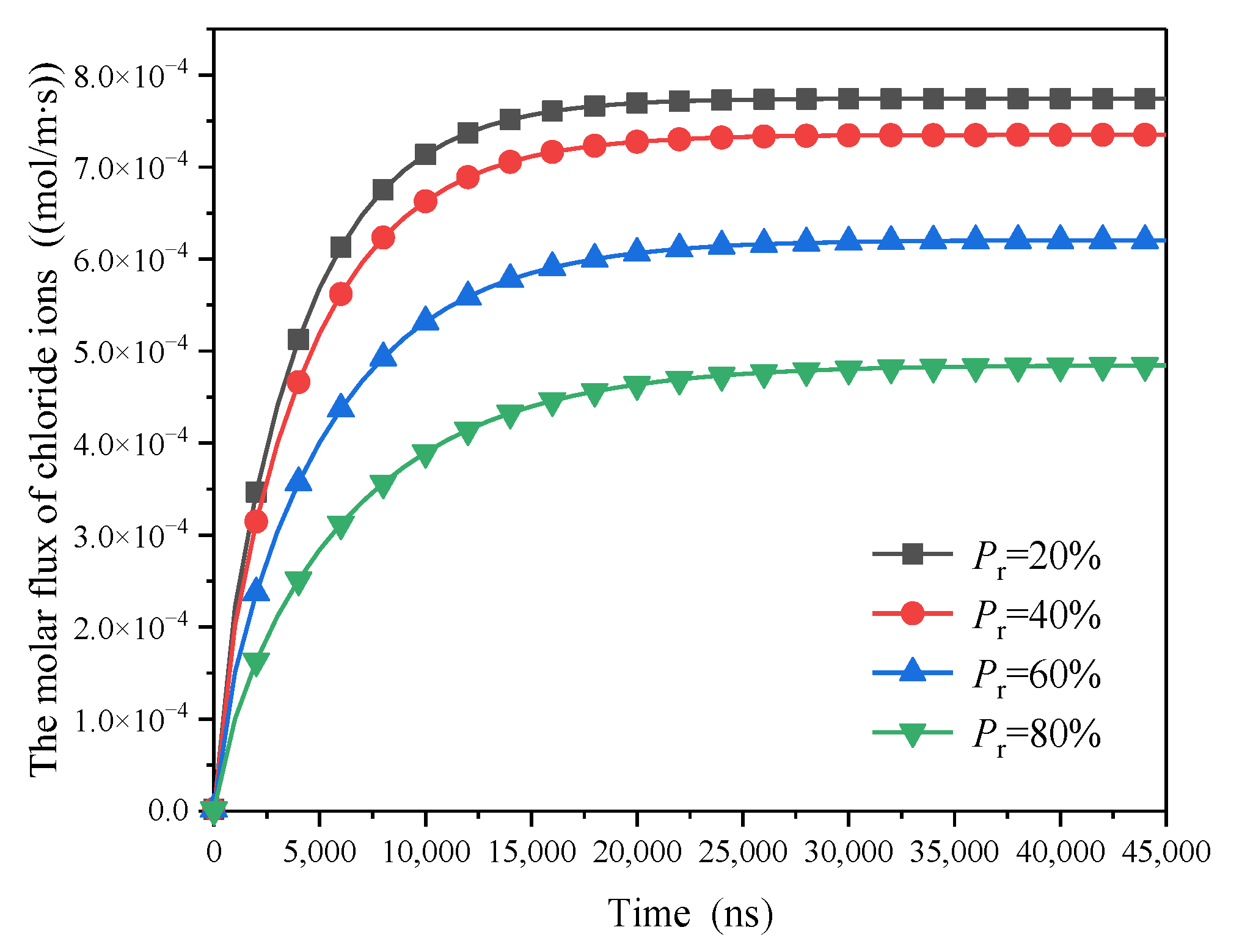
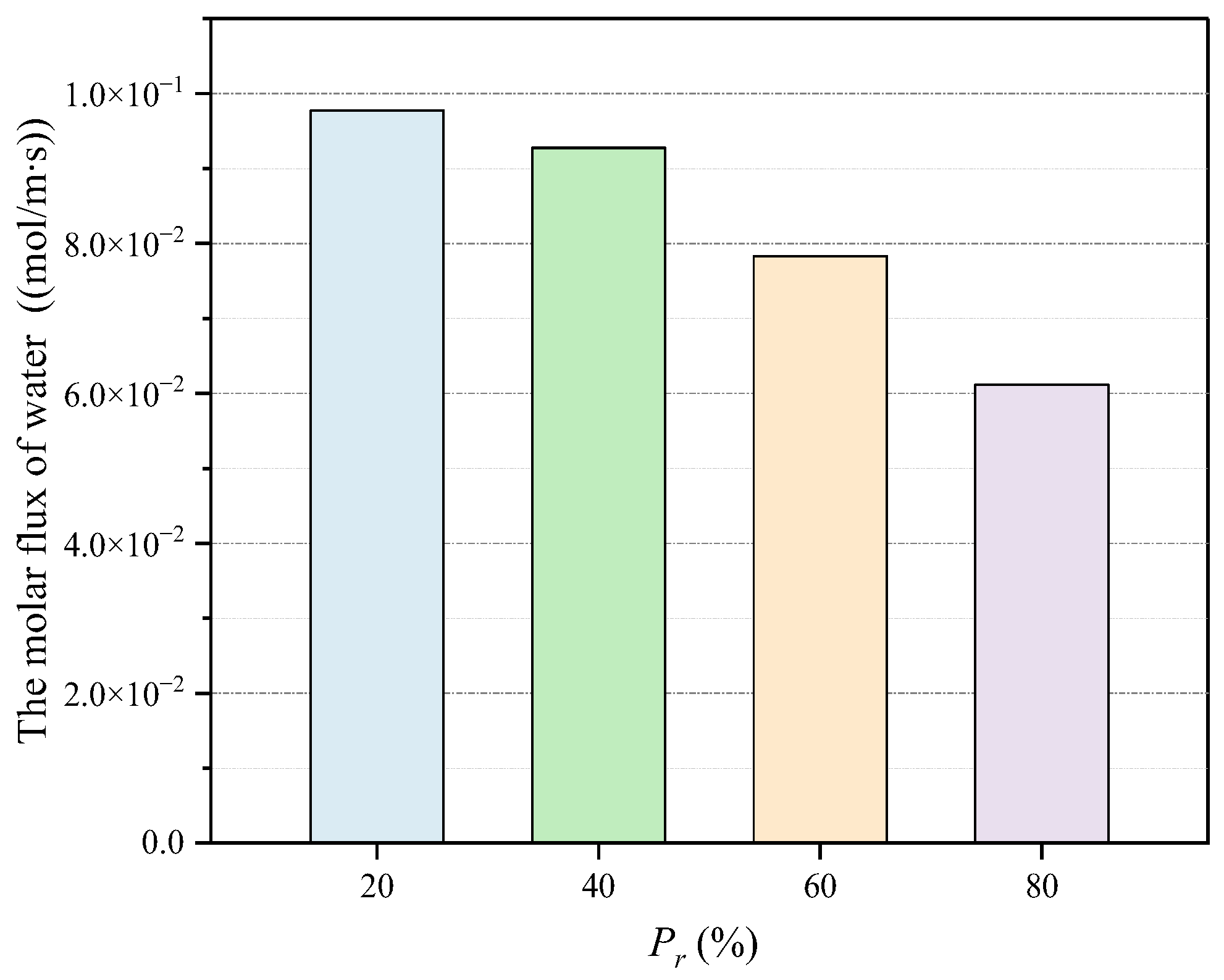
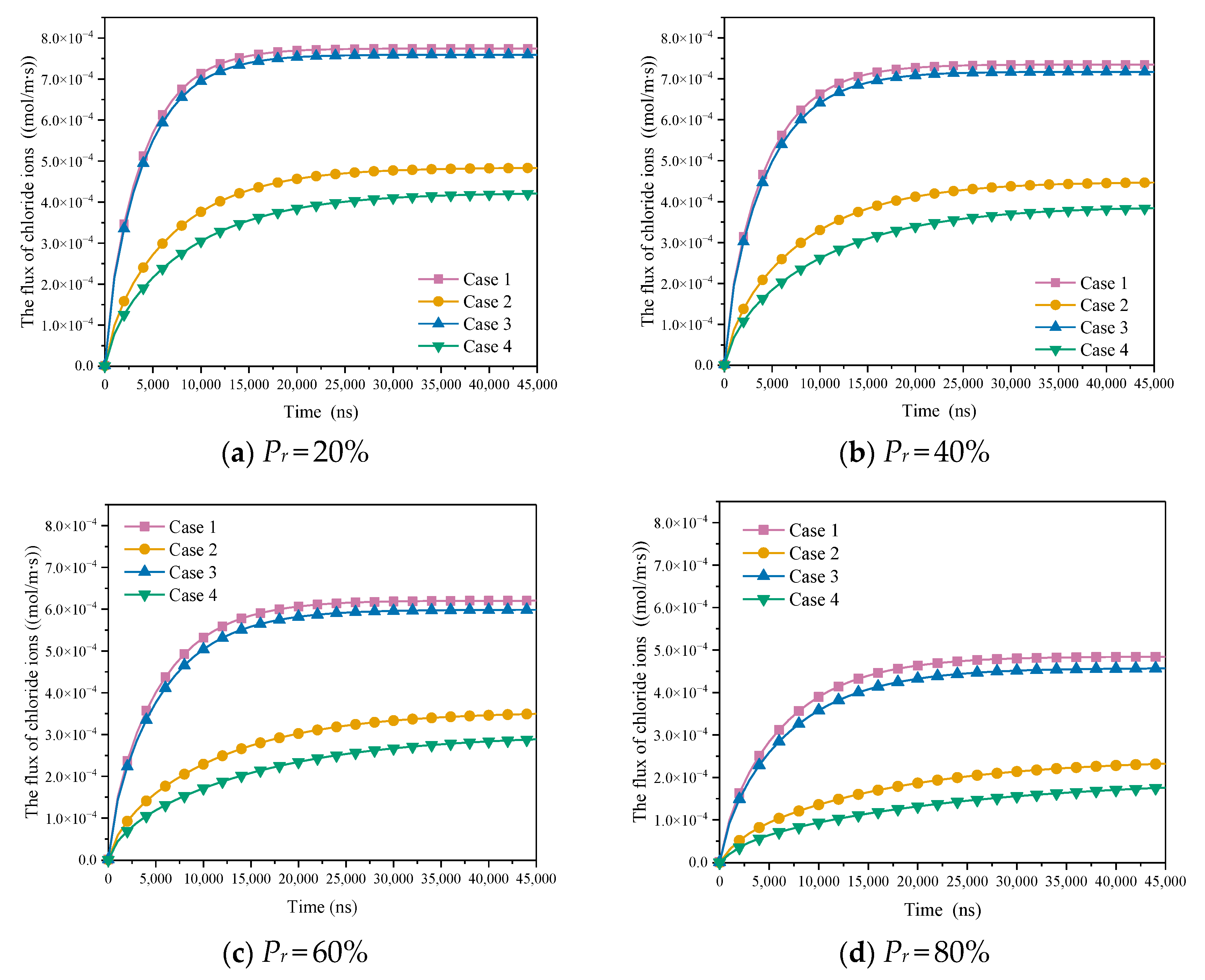
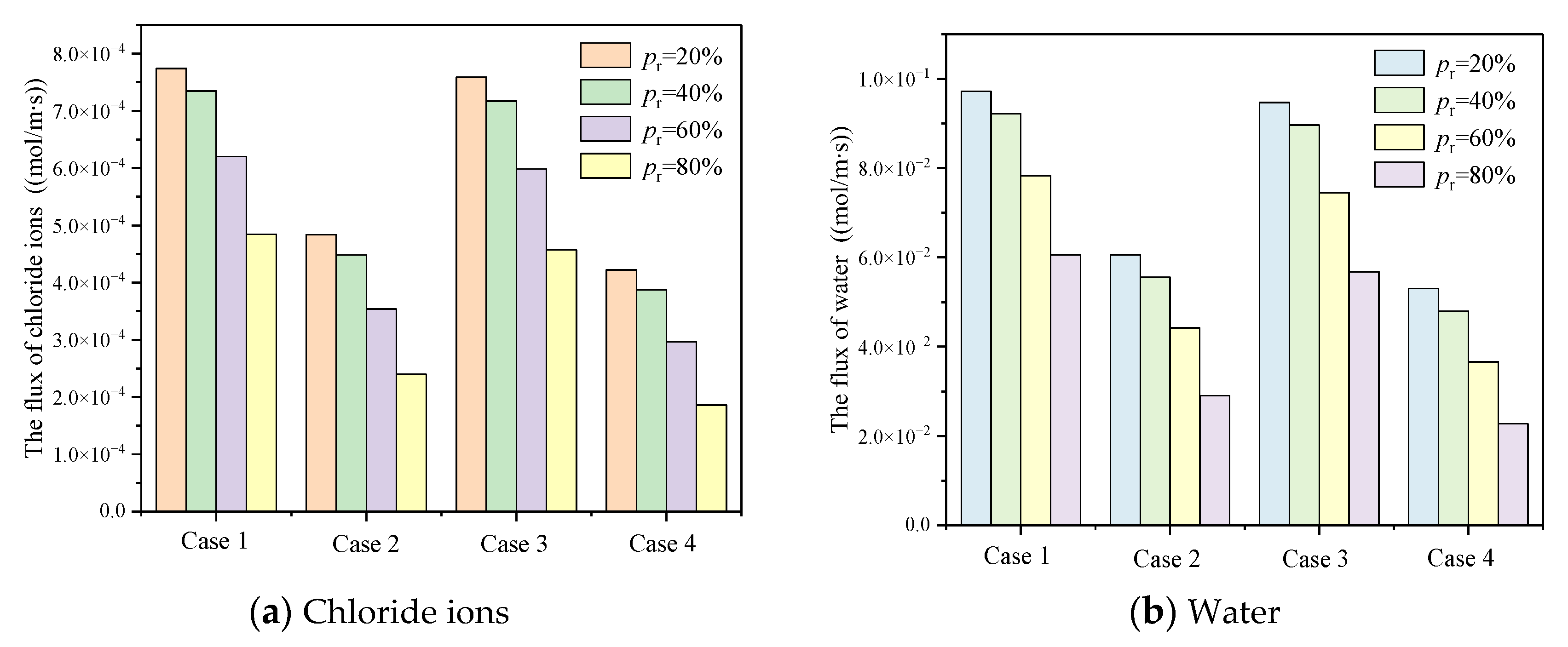

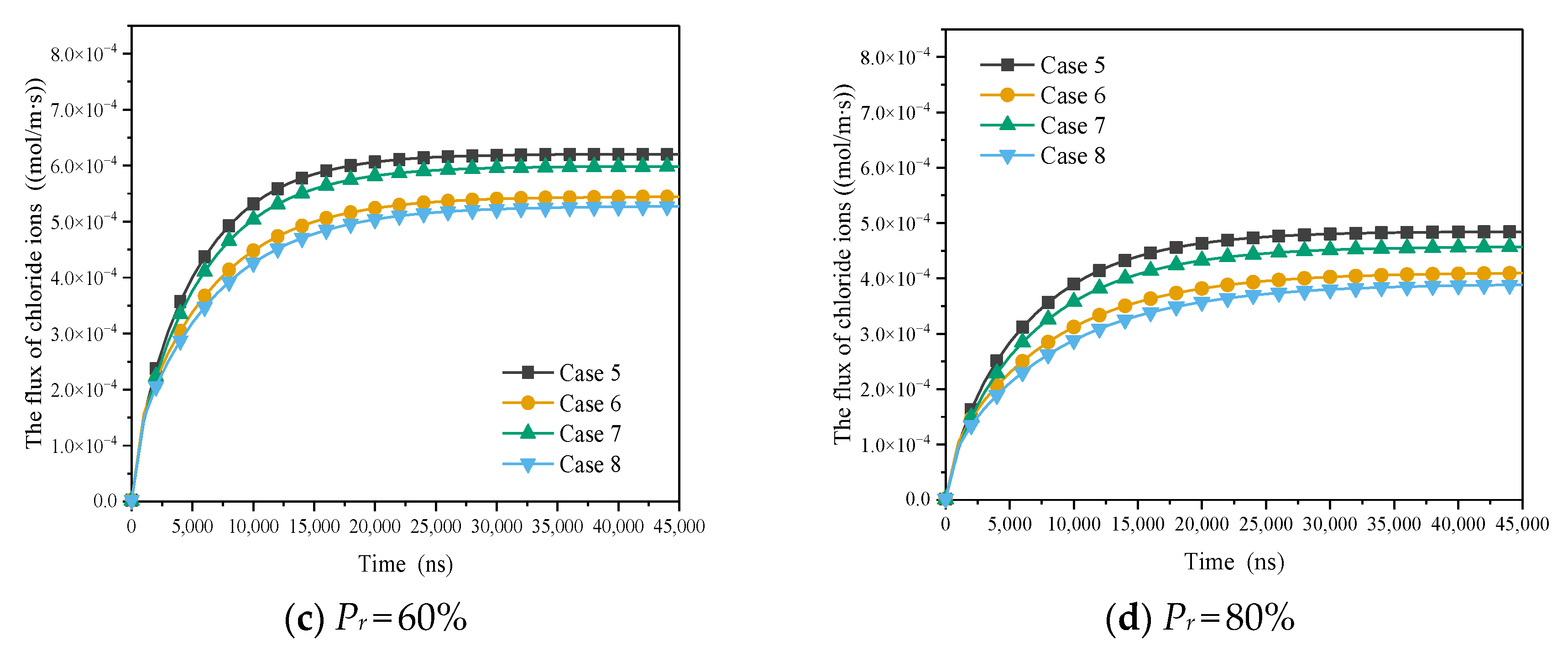
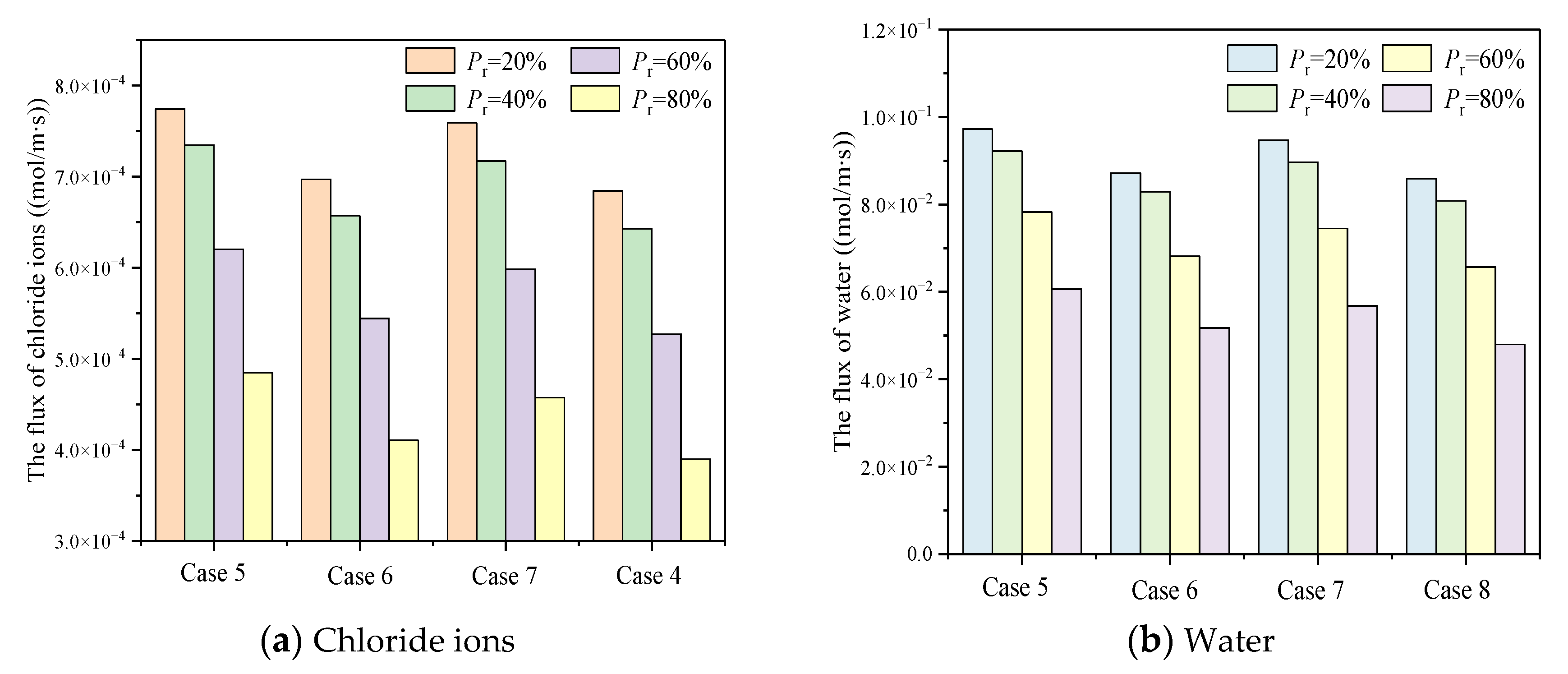
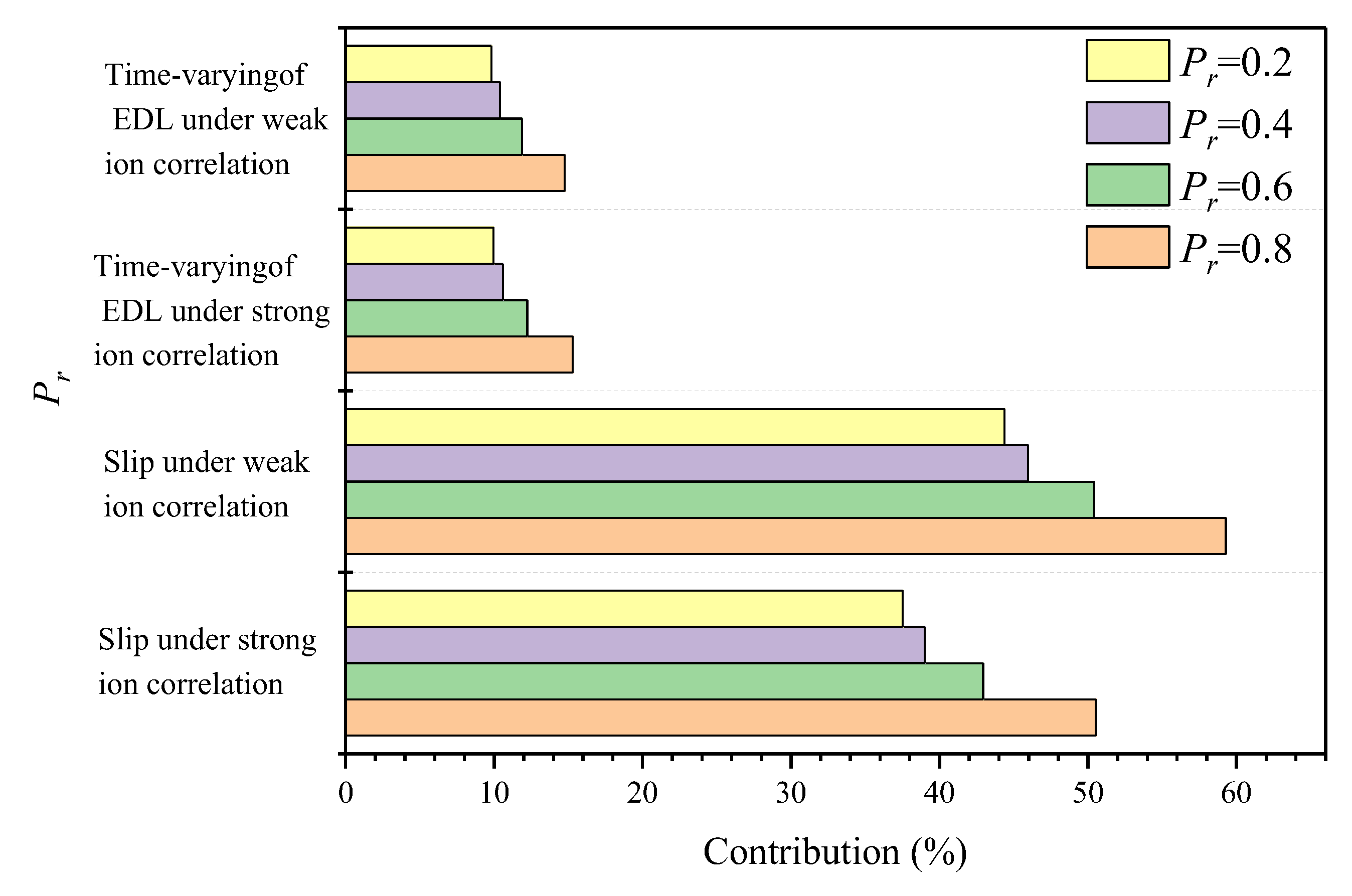
| Sample Number | Total Number of Pores | ||||
|---|---|---|---|---|---|
| 1 | 649 | 38,421 | 163 | 1130 | |
| 2 | 502 | 31,668 | 54 | 1090 | |
| 3 | 225 | 13,266 | 21 | 83.9 | |
| 4 | 182 | 22,561 | 43 | 68.3 |
| Sample Number | Total Number of Pores | ||||
|---|---|---|---|---|---|
| 1 | 568 | 32,634 | 154 | 208.46 | |
| 2 | 474 | 29,840 | 38 | 198.61 | |
| 3 | 189 | 11,304 | 14 | 12.74 | |
| 4 | 165 | 21,371 | 29 | 12.43 |
| Number | Case a | Case b | Case c | Case d |
|---|---|---|---|---|
| Pr (%) | 20 | 40 | 60 | 80 |
| Number | Case 1 | Case 2 | Case 3 | Case 4 |
|---|---|---|---|---|
| Factor | Considering slip under strong ion correlation | Ignoring slip under strong ion correlation | Considering slip under weak ion correlation | Ignoring slip under weak ion correlation |
| Number | Case 5 | Case 6 | Case 7 | Case 8 |
|---|---|---|---|---|
| Factor | Considering time-varying of EDL under strong ion correlation | Ignoring time-varying of EDL under strong ion correlation | Considering time-varying of EDL under weak ion correlation | Ignoring time-varying of EDL under weak ion correlation |
Publisher’s Note: MDPI stays neutral with regard to jurisdictional claims in published maps and institutional affiliations. |
© 2022 by the authors. Licensee MDPI, Basel, Switzerland. This article is an open access article distributed under the terms and conditions of the Creative Commons Attribution (CC BY) license (https://creativecommons.org/licenses/by/4.0/).
Share and Cite
Qi, Y.; Peng, W.; Zhang, W.; Jing, Y.; Hu, L. A Cross-Scale Framework for Modelling Chloride Ions Diffusion in C-S-H: Combined Effects of Slip, Electric Double Layer and Ion Correlation. Materials 2022, 15, 8253. https://doi.org/10.3390/ma15228253
Qi Y, Peng W, Zhang W, Jing Y, Hu L. A Cross-Scale Framework for Modelling Chloride Ions Diffusion in C-S-H: Combined Effects of Slip, Electric Double Layer and Ion Correlation. Materials. 2022; 15(22):8253. https://doi.org/10.3390/ma15228253
Chicago/Turabian StyleQi, Yunchao, Weihong Peng, Wei Zhang, Yawen Jing, and Liangyu Hu. 2022. "A Cross-Scale Framework for Modelling Chloride Ions Diffusion in C-S-H: Combined Effects of Slip, Electric Double Layer and Ion Correlation" Materials 15, no. 22: 8253. https://doi.org/10.3390/ma15228253
APA StyleQi, Y., Peng, W., Zhang, W., Jing, Y., & Hu, L. (2022). A Cross-Scale Framework for Modelling Chloride Ions Diffusion in C-S-H: Combined Effects of Slip, Electric Double Layer and Ion Correlation. Materials, 15(22), 8253. https://doi.org/10.3390/ma15228253




